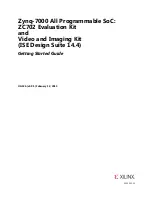
CY8CKIT-046 PSoC® 4 L-Series Pioneer Kit Guide, Doc. #: 002-03344 Rev. *D
75
Appendix
Figure A-18. Power Domain Restoration in Shield Board
A.3
Using FM24V10 F-RAM
The PSoC 4 L-Series Pioneer board has an onboard ferroelectric RAM chip that can hold up to 1 Mb
of data. The chip provides an I2C communication interface for data access. It is hardwired to the I2C
interface (P4[0] and P4[1] of the PSoC 4200L device); the same lines are routed to the KitProg I2C
interface. Because the F-RAM device is an I2C slave, it can be accessed or shared among various
I2C masters on the same lines. For more details on the F-RAM device, refer to the
.
A.3.1
Address Selection
The slave address of the F-RAM device consists of three parts, as shown in
: slave ID,
device select, and page select. Slave ID is an F-RAM family-specific ID provided in the datasheet of
the particular F-RAM device. For the device (FM24V10-G) used on the PSoC 4 L-Series Pioneer
board, the slave ID is 1010b. Device select bits are set using the two physical pins A2 and A1. The
setting of these two pins on the PSoC 4 L-Series Pioneer board is controlled by resistors R30/R31
(A2) and R36/R37 (A1). Because the memory location in F-RAM is divided into two pages of 64 KB
each, the page select bit is used to refer to one of the two pages in which the read or write opera-
tions will take place.
Note:
The 8-pin SOIC footprint provided for the F-RAM FM24V10 on the PSoC 4 L-Series Pioneer
Kit is compatible with all I2C-based F-RAM devices from Cypress (FM24Vxx, FM24CLxx, and
CY15BxxxJ parts). The F-RAM parts with more than 64 KB size support only four addresses (four
devices of the same type on the same I2C bus); resistors connected to A1 (R36/R37) and A2 (R30/
R31) pins can be used to select any of the four addresses. The F-RAM parts with less than 64 KB
and FM24CLxx parts support eight addresses; resistors connected to A0 (R94/R95), A1 (R36/R37),
and A2 (R30/R31) pins can be used to select one of the eight addresses.
Figure A-19. F-RAM I2C Address Byte Structure
















































